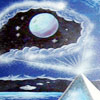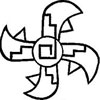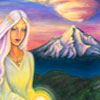The Sleeping Prophet On Lemuria
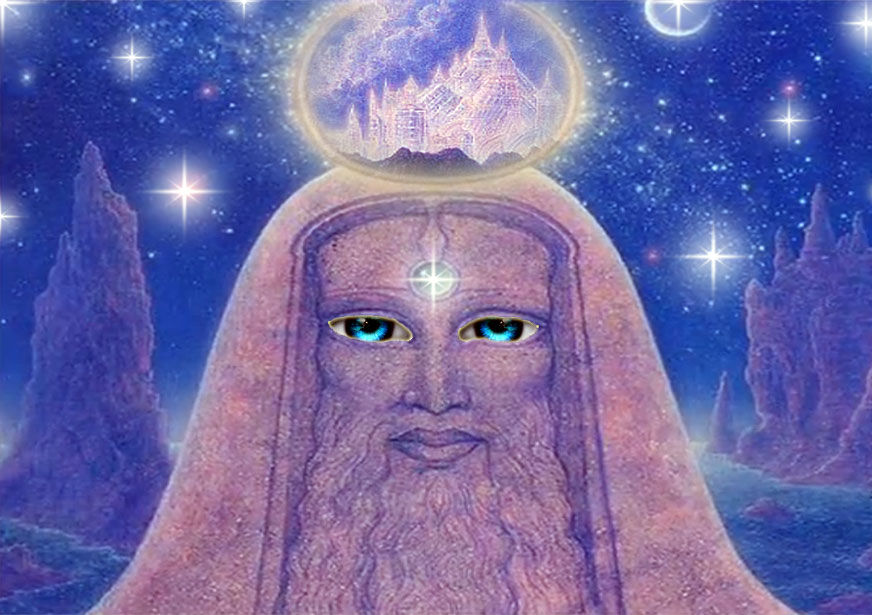 by Frank Joseph
by Frank Joseph
Edgar Cayce is thought by many to have been the greatest clairvoyant and prophet since the days of apostolic revelation. ~ Brad Steiger
Of our era’s alleged “psychics,” one name stands out. Edgar Cayce’s status as a genuine seer not only survived his mid-twentieth-century death into the next millennium, but has grown considerably beyond his lifetime reputation as well. The cause is not difficult to understand. His forty years of subconscious health pronouncements form a body of recorded medical information sought out by sufferers from around the world as effective countermeasures to invasive surgical procedures. His reputation as a healing intuitive aside, the far fewer utterances he made about Lemuria are not, as skeptics might expect, statements of wild fantasy, but instead remarkably consistent, and well within the scope of archaeology and geology. More valuably, they shed new light on the people, spirituality, and destiny of Mu otherwise unavailable from conventional sources. Whether or not we give any credence to psychics, renowned or otherwise, his characterization of Lemurian people and events is surprisingly credible and illuminating if viewed through the lens of neither preconceived belief nor unbelief.
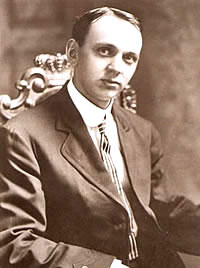 Born in 1877 in Kentucky, Cayce was known as the Sleeping Prophet because he offered cures while in a deep trance. Until his death in Virginia sixty-eight years later, Cayce dictated thousands of “life readings” allegedly obtained from a kind of spiritual record he claimed to be able to read while experiencing an altered state of consciousness. His formal education was meager, and points of reference were for him more spiritual than historical or academic. His grasp of the world was often biblical, not scholastic. It seems clear, then, that considerations of a sunken civilization were beyond the scope of his rural background, his fundamentally Christian world-view, and even his interests. Nonetheless, he inexplicably began talking about sunken cities one day during the course of giving medical advice after nearly twenty years without mentioning a lost civilization. Awake, he knew virtually nothing about Atlantis and less concerning Lemuria. Yet their sudden appearance among the life readings was entirely in keeping with his therapeutic counsels.
Born in 1877 in Kentucky, Cayce was known as the Sleeping Prophet because he offered cures while in a deep trance. Until his death in Virginia sixty-eight years later, Cayce dictated thousands of “life readings” allegedly obtained from a kind of spiritual record he claimed to be able to read while experiencing an altered state of consciousness. His formal education was meager, and points of reference were for him more spiritual than historical or academic. His grasp of the world was often biblical, not scholastic. It seems clear, then, that considerations of a sunken civilization were beyond the scope of his rural background, his fundamentally Christian world-view, and even his interests. Nonetheless, he inexplicably began talking about sunken cities one day during the course of giving medical advice after nearly twenty years without mentioning a lost civilization. Awake, he knew virtually nothing about Atlantis and less concerning Lemuria. Yet their sudden appearance among the life readings was entirely in keeping with his therapeutic counsels.
During the early 1920s, in the course of listing and describing the root causes for various inexplicable ailments afflicting his clients, Cayce stated that these apparently baseless health problems were the subconscious residue of negative behavior carried over from previous lives in Atlantis a very long time ago. Unresolved at the time of its cataclysmic destruction, their “bad karma” carried over millennia of incarnations, reflecting each one into the present lifetime as guilt complexes, resulting in so-called psychosomatic conditions—actually, physical reflexes or reactions to spiritual pain, hence their suffering from incarnation to incarnation. “There can be no physical healing,” Cayce often repeated, “without spiritual healing, because the soul is the seat of our being.”
For more than twenty years after first startling his clients with their former lives in the sunken capital, Cayce went on to discuss Atlantis in many hundreds of life readings, though far less frequently mentioning Mu or Lemuria. When asked why, he responded that the Atlanteans had behaved very badly, accumulating enormous karmic debt that needed to be set right over the course of numerous reincarnations. The virtuous Lemurians, spiritually solvent (for the most part) to the end, had incurred less soul debt and were subsequently freer from the soul-cleansing round of birth-death-rebirth.
America’s renowned medical intuitive often mentioned Atlantis during his altered states of consciousness. But his description of the lost civilization was less for historical purposes than to provide a setting for past-life behavior. According to Edgar Cayce, important ethical decisions acted on in the ancient past contributed over subsequent reincarnations of a particular soul to its development, down to the present time. He believed that the predicaments or circumstances of the individuals who sought his counsel during the early twentieth century sometimes found their karmic roots in prehistory. Cayce was chiefly interested in Atlantis only insofar as it helped shed light on the spiritual condition of his clients. And since the Atlanteans were supposed to have been a morally challenged people, most of his life readings concerned men and women who long ago dwelled in the doomed oceanic kingdom.
He found far fewer with a Lemurian background. Because the Pacific Motherland missed the materialism and wars that characterized its Atlantic counterpart, its more peaceful inhabitants had less karmic repercussions. What he did say about Lemuria, however, illuminated the lost realm from a unique perspective. Beyond any psychic or karmic considerations, Cayce’s readings about Mu or Lemuria are self-evidently plausible, because they often contain information that made little or no sense at the time they were made, but have been since confirmed in many instances by subsequent discoveries in geology and archaeology.
A case in point was his description of a forgotten civilization he claimed flourished in what is now the Gobi Desert many thousands of years ago, when it was created by “those from the land of Mu” (1273-1 M.40 10/16/36). Living conditions then were utterly unlike the hostile environment for which the region is infamous, Cayce said, and it began to deteriorate rapidly to its presently uninhabitable status immediately following the Great Flood. Recalling the Lemurian Garden of Eden, he spoke of “the first appearances of the Adamic influence that came to Asia and the Near East through that now known as the Gobi land” (1210-1 M.54 6/29/36).
When Cayce made these statements in the mid-1930s, few people knew what he was talking about. One who did was James Churchward, whose several volumes about the Pacific Motherland had been recently published. In his first book, The Lost Continent of Mu, he declared, “At the time of the Uighur Empire, the Gobi Desert was an exceedingly fertile area of land.” The Uighur was the principal colonial holding belonging to Mu at the time of the biblical “flood, which destroyed its eastern half. Eventually, the Uighurs extended themselves into Europe around the western and northern shores of the Caspian Sea, as related in a very old Hindu record; from there, they continued on through Central Europe.”
During the lifetimes of Cayce and Churchward, and long after their deaths, both men were almost universally ridiculed by professional geologists and archaeologists for such statements. The Gobi Desert was generally believed to have always been an immense wasteland, never the “exceedingly fertile area” portrayed by the psychic and the colonel. Scanty records referred to a twelfth-century Uighur “kingdom” of sorts in inner Asia, but nothing earlier. Today’s Uighurs are a sedentary people whose social organization revolves around village life in northwestern China, where they subsist on kaoliang, a kind of sorghum. “There seems to be little direct connection between the medieval people and those now bearing the name,” according to Rudy Evermann, a specialist in the history of the Gobi Desert. A Uighur impact on Europe appeared ludicrous, and a crazy reversal of European influences on the east deemed incontrovertible by scholars.
In 1962, however, geological opinion was turned on its ear by abundant physical evidence proving that the Gobi region had indeed alternated between extended periods of fertility and aridity over the last few million years. The most recent environmental events occurred at the close of the Pleistocene epoch, 12,000 Y.B.P., and again around the turn of the fourth millennium B.C. As recently as 3,000 years ago, shepherds were tending flocks of sheep where today an ocean of sand spreads beyond the horizon. An even greater shock to conventional wisdom occurred in the following decade, when the corpse of a fair-complected, red-haired adult male was found in central Asia. Almost perfectly intact because he had been naturally mummified by arid conditions of the Takla Makan Desert, the man was dated to nearly 10,000 years ago, millennia before the arrival of the first Chinese.
Nor was he alone. The remains of other contemporary as well as later white-skinned men, women, and children were excavated, more than 500 alone in the Uigher areas of Ueruemchi and Tarim. Discoveries continued into the early twenty-first century, when a cemetery of several hundred more Caucasian mummies was unearthed in the eastern Gobi during summer 2004 by Chinese archaeologists. Investigators were especially struck by the advanced state of attire worn by many of the corpses. They were dressed in beautifully made felt shirts, tailored trousers, elaborate skirts with handsome belts, silk scarves, and leather jerkins, and they were shod in deerskin shoes or slippers.
The profusion and consistently skillful execution of their remarkably well-preserved clothing underscored Churchward’s comments made fifty years before: “The Uighurs had reached a high state of civilization and culture; they knew astrology, mining, the textile industries, architecture, mathematics, agriculture, writing, reading, medicine, etc. They were experts in decorative art on silk, metals and wood, and they made statues of gold, silver, bronze and clay; and this was before the history of Egypt began.” Archaeologists traced some of the Ueruemchi mummy styles and design patterns to central Europe, again as Churchward had indicated decades earlier.
“The history of the Uighurs,” Churchward stressed in italics, “is the history of the Aryans,” foreshadowing the anomalous discovery of ancient Caucasians in northwestern China, just where Cayce also spoke of an “Adamic” civilization in “the Gobi land.”
On February 16, 1932, Cayce said, “Lemuria began its disappearance—even before Atlantis . . . ten thousand, seven hundred light-years, or Earth years, or present setting of those, as set by Amilius—or Adam” (364-4) . . . Seemingly ambiguous concerning the chronology for Lemuria by this statement, his other brief references to Lemuria were far more direct. A case in point is among the first statements he made about the lost Motherland, when he touched on Lemuria only briefly in his lengthy response to a question concerning geographical and geological conditions on Earth at the time Homo sapiens sapiens came into being. “The Andean, or the Pacific coast of South America,” he said, “occupied then the extreme western portion of Lemuria.” Sixty years after he made this statement, California’s Scripps Oceanographic Service published a series of maps revealing the latest discoveries in sea-floor research. One such map details and names the Nazca Ridge, a former land bridge of more than 200 miles long that once connected the Peruvian coast at Nazca with a sunken archipelago. In 1932, Cayce appears to have identified an underwater feature unknown to science until the 1990s, thereby providing substantive evidence for Lemuria’s existence.
Ironically, his first mention of the Pacific civilization, nine months after prophetically alluding to the yet undiscovered Nazca Ridge, details the beginning of its demise. He stated that a “portion” of “Lemuria began it disappearance” 10,700 years ago. This time period coincides remarkably well with the final moments of the last ice age, when melting glaciers generated dramatic increases in the global sea level, drowning coastal regions and far-flung lowland territories around the world. Lemuria and its culture continued to survive and prosper long after some territories were lost in the ice-age deluge, just as Cayce said. But related archaeological evidence tends to confirm his rough date for this early flood.
Simultaneous with dynamic sea-level rises and Cayce’s eleventh millennium-B.C. date was the sudden emergence of the sophisticated Jomon culture in Japan and the contemporary drowning of Yonaguni’s sunken ceremonial structure. These two apparent consequences of the concluded ice age imply that Lemurian refugees migrated to places like Yonaguni from the larger Japanese islands of Honshu and Hokkaido. After the ice-age flood, according to Cayce, the Lemurians began long-range voyages—at least their missionary representatives traveled throughout the world on behalf of spreading the Lemurian gospel. He describes their temple-building activities in Yucatan, and representatives from Mu were said to have been on hand for opening ceremonies of the Great Pyramid at the Nile Delta.
These and other events come into sharper focus through the names Cayce provided of the men and women who actually participated in them. In life reading 1159-1 F.80 for May 5, 1936, he spoke of Amululu, “a priestess . . . who came west from the activities of the Lemurian land.” The civilizing influences she helped bring into Peru formed “what later became known as the Incals.” Amululu taught and supervised the production of “metals, crockery, woven cloth, the use or application of these in the services not only for the places of abode, but for the places of amusements or for places of worship.”
Many of the Lemurians he mentioned by name, like Amululu, were deeply involved in civilizing South America. Om-muom appears to have been among the first, when he labored in Peru at “the beginnings of the communications with those of many other lands” after the onset of geologic trouble threatening to break up the old Atlanto-Lemurian world. During the seismic violence of those times, the best and worst in human beings, then as now, emerged. Omuld and Oumu were cited by Cayce as Om-muom’s contemporaries who lost their nerve during the Peruvian experience, while Ulmu lost something more—his life, while trying to rescue others imperiled by the natural catastrophes bedeviling South America and much of the rest of the world.
Lemurian spiritual greatness, Cayce observed, was superior even to the high levels of paranormal power developed in Atlantis. Here he is richly validated by an abundance of Asian, Australian, Pacific islander, and pre-Columbian American traditions that define their versions of Lemuria as the sunken Motherland of sacred wisdom. Australian Aborigines believe that the tenets of their Dream-time cult arrived from the “land of Perfection” before it was engulfed by the sea. Burotu is remembered as the sunken realm of powerful priests who spread the secrets of their high magic from Tonga to the Fiji Islands. The Chumash Indians of southern coastal California believed that the ancestors of their medicine men were missionaries from Lemuria, after which one of their offshore islands was originally named.
Excerpt from The Lost Civilization of Lemuria
See Part II here.
Posted in Lemuria, Other Topics, True History of Manwith comments disabled.



